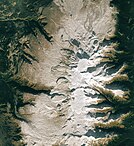Wikipedia:2012 main page redesign proposal/Inkowik
|
Welcome to Wikipedia, |
6,939,421 articles in English — New contributors are welcome
|
|
Today's featured article
 Big Raven Plateau, at the northern end of the Mount Edziza volcanic complex Volcanism of the Mount Edziza volcanic complex in British Columbia, Canada, spans more than 7 million years. The first magmatic cycle took place between 7.5 and 6 million years ago and is represented by the Raspberry, Little Iskut and Armadillo geological formations. Volcanism has taken place during five cycles of magmatic activity, each producing less volcanic material than the previous one. During these cycles volcanism has created several types of volcanoes, including cinder cones, stratovolcanoes, subglacial volcanoes, shield volcanoes and lava domes. The roughly 1,000-square-kilometre (400-square-mile) volcanic plateau of the MEVC originated from the successive eruptions of highly mobile lava flows. Several types of volcanic rocks were deposited by multiple eruptions of the MEVC. At least 10 distinct flows of obsidian were produced by volcanism of the MEVC, some of which were exploited by indigenous peoples in prehistoric times to make tools and weapons. (Full article...)
Recently featured:
On this day...
January 13: Eugenio María de Hostos's birthday in Puerto Rico (2025); Saint Knut's Day in Finland and Sweden
More anniversaries:
|
In the news
Did you know...
|

|
The fork-tailed flycatcher (Tyrannus savana) is a bird in the family Tyrannidae, the tyrant flycatchers. Named after their distinguishably long, forked tails, particularly in males, fork-tailed flycatchers are seen in shrubland, savanna, lightly forested and grassland areas, from southern Mexico south to Argentina. They tend to build their cup nests in similar habitats to their hunting grounds (riparian forests and grasslands). Males perform aerial courtship displays to impress females involving swirling somersaults, twists, and flips, all partnered with their buzzing calls. These courtship displays utilise the long tail feathers. This male fork-tailed flycatcher of the subspecies T. s. monachus was photographed in Cayo District, Belize, demonstrating its characteristic forked tail while in flight. Photograph credit: Charles J. Sharp
Recently featured:
|
Wikipedia is written by volunteer editors and hosted by the Wikimedia Foundation, a non-profit organization that also hosts a range of other volunteer projects:
-
Commons
Free media repository -
MediaWiki
Wiki software development -
Meta-Wiki
Wikimedia project coordination -
Wikibooks
Free textbooks and manuals -
Wikidata
Free knowledge base -
Wikinews
Free-content news -
Wikiquote
Collection of quotations -
Wikisource
Free-content library -
Wikispecies
Directory of species -
Wikiversity
Free learning tools -
Wikivoyage
Free travel guide -
Wiktionary
Dictionary and thesaurus



